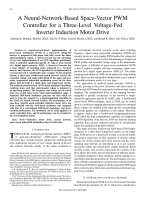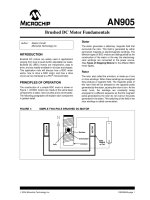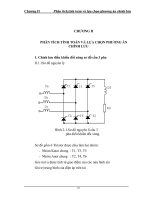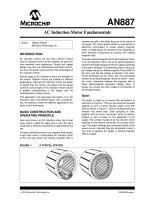AC motor doc
Bạn đang xem bản rút gọn của tài liệu. Xem và tải ngay bản đầy đủ của tài liệu tại đây (1.77 MB, 64 trang )
Course
"EEM 41 Three-phase asynchronous machines"
Photo: ABB Group
SH5007-1D Version 1.0
Author: M.Germeroth
Lucas-Nülle GmbH · Siemensstraße 2 · D-50170 Kerpen (Sindorf)
Tel.: +49 2273 567-0
www.lucas
-nuelle.de
Copyright © 2006 LUCAS-NÜLLE GmbH.
All rights reserved.
LUCAS-NÜLLE Lehr- und Messgeräte GmbH
Siemensstraße 2 D-50170 Kerpen
EEM41 Three-phase asynchronous machines
Training objectives 1
Equipment: 300 W Industrial Series 2
Safety 3
Asynchronous motor 5
Connection and starting
7
Rotation reversal
17
Load characteristics
23
Reactive compensation
31
Asynchronous motor, Steinmetz circuit 43
Connection and starting
45
Load characteristics
51
Copyright 57
EEM41 Three-phase asynchronous machines
EEM41 Three-phase asynchronous machines
Training objectives
This course is designed to convey practical know-how on the topic of three-phase
asynchronous machines.
Experiment-based investigations of the asynchronous motor are the focus and cover
the functioning of the machine, its response and how it operates.
Training contents
z
Motor operation
z
Nominal data, rating plate
z
Star cnnection, delta connnection
z
Star/delta switches
z
Steinmetz circuit (300W series)
z
Reactive power compensation
z
Measurement of phase-to-phase and line-to-line values
z Reversal of rotation
z Measurement of power output with and without oad
Prerequisites
z Basic knowledge of electrical machines
z Basic knowledge of electrical engineering
z Knowledge of using measuring instruments
Welcome to the Three-phase Asynchronous Machine course. The
team from LUCAS-NÜLLE wishes you lots of fun and success while
working through the course topics and performing the experiments. The
following pages provide you with an overview of the course content and
the required materials.
1
EEM41 Three-phase asynchronous machines
Equipment: 300 W Industrial Series
SO3636-6U Active machine test stand 300 W 1 each
SE2662-2A Coupling sleeve 300 W 1 each
SE2662-7B Coupling guard 300 W 1 each
SE2672-3G
Three-phase motor with squirrel-cage rotor
300 W
1 each
SO3212-1W On/off switch 4-pole 1 each
SO3212-2D Star-delta switch 1 each
SO3212-5U Power supply for electrical machines 1 each
SO5127-1Z
Analog/digital multimeter, power meter and
power factor meter
1 each
SO3212-6E Compensation unit 1 each
SO5148-1F
Set of safety connecting leads 4 mm
(47 each)
1 each
SO5126-9X
Set of safety connection plugs 19/4 mm
(15 each)
15 x
SO5126-9Z
Set of safety connection plugs 19/4 mm with
tap (5 each)
5 x
2
EEM41 Three-phase asynchronous machines
Safety
Basic safety instructions
In all experiments using mains voltages high, life-threatening voltages arise. For that
reason use only safety measurement leads and make sure that there are no short-
circuits.
It is imperative that all of the devices, which are provided with an earth or where
earthing is possible, must be earthed. This is particularly the case for the frequency
converter being used.
Always be very careful to check the wiring of the application modules and only
switch on the mains voltage after a check has been completed. Whenever possible
use a robust current monitoring instrument in the circuit.
Always use shaft-end guards and coupling guards as protection against contact
with rotating motor parts
All locally applicable stipulations and standards governing how electrical equipment
is handled must be complied with.
3
EEM41 Three-phase asynchronous machines
Safety
General instructions on handling the equipment
{ Check that the knurled screws at the base of the motor and the coupling
sleeves (power grip) on the motor shaft are all securely fastened.
{ Use shaft and coupling guards.
{ Any prolonged running of the machines when operating under high loads
can subject the machines to excessive heating.
{ The extreme case of the machine being prevented from rotating entirely
may only arise briefly.
{
All of the machines are equipped with a thermal circuit-breaker, which
triggers when the maximum permissible operating temperature is
exceeded. These switching contacts are accessible on the terminal
board and must always be connected to the corresponding connection
sockets of the mains supply and control unit.
{
All measurements have been recorded using conventional measuring
instruments (primarily class 1.5) at the standard mains voltage
(230/400V +5% -10% 50Hz) using standard production machines.
Experience suggests that measurements will lie within the tolerance
range of +/-15% with respect to the specified measurement. For more
information on this please refer to VDE0530.
4
EEM41 Three-phase asynchronous machines
Asynchronous motor
Asynchronous motors
z Connection and starting
z Rotation reversal
z Load characteristics
z Dynamic load experiments (Classic series only )
z Reactive power compensation
On the subsequent pages you will be performing the following exercises
on the "asynchronous motor":
5
EEM41 Three-phase asynchronous machines
Asynchronous motor
6
EEM41 Three-phase asynchronous machines
Asynchronous motor
Enter the nominal data for the asynchronous machine
What is the maximum permissible voltage of the motor winding (phase voltage)?
Training content: Connection and starting
z Identify the terminal connections of the motor and operate the
motor as a three-phase asynchronous motor on a three-phase
mains network
z Utilise the nominal data of the motor based on the rating plate
z Measure the phase voltage and phase current
z Put the motor into operation in star and delta configurations
z Identify the differences between star and delta connections
z
Understand the function of adelta switch
z
Put the motor into operation with the brake
z
Subject the motor to load
Nominal power
___
_
W
U
N
star circuit connection
___
_
V
U
N
delta circuit connection
___
_
V
I
N
star circuit connection
___
_
A
I
N
delta circuit connection
___
_
A
cos φ
___
_
Speed
___
_
rpm
Frequency
___
_
Hz
U
phase
=
___
_
V
7
EEM41 Three-phase asynchronous machines
Asynchronous motor
Assembly instructions: "Connection and starting"
More detailed information on the brake can be found in the corresponding online
documentation
Circuit diagram "connection & starting" (star configuration)
z
Assemble the circuits as specified in the following circuit diagram and
set-up instructions
z Switch on the brake too. This does not yet subject the motor to any load
8
EEM41 Three-phase asynchronous machines
Asynchronous motor
Set-up "Connection & starting" (star configuration)
Putting the asynchronous motor into operation in star configuration
Required settings:
z Brake mode: "Torque Control"
9
EEM41 Three-phase asynchronous machines
Asynchronous motor
Experiment procedure:
z Put the motor into operation and observe its response
z Brake the motor down to its nominal speed
z
At the same time measure the phase variables U
phase
and I
phase
Make sure that the ammeter and voltmeters have been connected properly
What do you measure the phase variables U
phase
and I
phase
to be?
U
phase
=
___
_
V
I
phase
=
___
_
A
10
EEM41 Three-phase asynchronous machines
Asynchronous motor
Circuit diagram "Connection & starting" (delta connection)
11
EEM41 Three-phase asynchronous machines
Asynchronous motor
Set-up "Connection & starting" (delta connection)
Putting the asynchronous motor into operation in delta configuration
Required settings:
z
Brake mode: "Torque Control"
Experiment procedure:
z
Put the motor into operation and observe its response
z
Brake the motor down to its nominal speed
z
At the same time measure the phase variables U
phase
and I
phase
Make sure that the ammeter and voltmeters have been connected correctly
12
EEM41 Three-phase asynchronous machines
Asynchronous motor
What do you measure the phase variables U
phase
and I
phase
to be?
Circuit diagram "Connection & starting" (star and delta switch)
U
phase
=
___
_
V
I
phase
=
___
_
A
13
EEM41 Three-phase asynchronous machines
Asynchronous motor
Set-up "Connection and starting" (star and delta switch)
Putting the asynchronous motor into operation with a star/delta switch and
recording the load characteristics
Required setting:
z
Brake mode: "Torque mode"
Experiment procedure:
z
One load characteristic each is to be recorded for the star and delta circuits
z
Subject the motor to the load torques as given in the table
z
Enter the measured values (M, n, U
phase
, I
phase
) into the tables
14
EEM41 Three-phase asynchronous machines
Asynchronous motor
Table1 (star connection)
Table2 (delta connection)
M/Nm 0 0.1 0.3 0.5 0.7 0.9
n/(1/min)
Ustr/V
Istr/A
0.0 0.1 0.2 0.3 0.4 0.5 0.6 0.7 0.8 0.9 1.0 1.1 1.2
M/Nm
0
200
400
600
800
1000
1200
1400
1600
1800
2000
2200
2400
2600
2800
3000
n/(1/min)
0
50
100
150
200
250
Ustr
0.0
0.1
0.2
0.3
0.4
0.5
0.6
0.7
0.8
0.9
1.0
1.1
1.2
1.3
1.4
1.5
Istr
M/Nm 0 0.5 1 1.5 2 2.5
n/(1/min)
Ustr/V
Istr/A
0.0 0.2 0.4 0.6 0.8 1.0 1.2 1.4 1.6 1.8 2.0 2.2 2.4 2.6 2.8 3.0
M/Nm
0
200
400
600
800
1000
1200
1400
1600
1800
2000
2200
2400
2600
2800
3000
n/(1/min)
0
50
100
150
200
250
300
350
400
Ustr
0.0
0.3
0.6
0.9
1.2
1.5
1.8
2.1
2.4
2.7
3.0
Istr
15
EEM41 Three-phase asynchronous machines
Asynchronous motor
Which of the statements below are true?
gfedc
The maximum torque of the motor is identical for
both circuit types
gfedc
In star configuration the phase current is lower
gfedc
A delta connection offers the better speed/torque
ratio as compared to a star circuit
gfedc
The starting current is generally lower for the star
connection than delta configuration
gfedc
The star/delta switch has practically no significance
at all
gfedc
The star/delta switch permits the motor to start "more
smoothly"
gfedc
In practice asynchronous motors are operated only in
star configuration
16
EEM41 Three-phase asynchronous machines
Asynchronous motor
Definition of rotation direction
If you look at the drive shaft end of the asynchronous machine from the perspective
of the working machine (in our case the brake), the rotating direction is positive
when it is clockwise. If the motor has two workable shaft ends, then it is the shaft
end opposite the cooling vents, collector or slip-rings that is the shaft end which
defines the rotation direction.
Note: in the "Classic series" (0.3 KW & 1.0 KW) the rotation direction is
determined by the rotation direction of the brake, i.e. if the asynchronous machine
rotates clockwise, i.e. in the positive direction, the control unit of the brake indicates
a negative rotation direction. Thus the rotation direction displayed is always that of
the brake.
Training content: "Rotation reversal"
z Identify the difference between clockwise and anti-clockwise
rotation
z Put the motor into operation in both rotation directions
17
EEM41 Three-phase asynchronous machines
Asynchronous motor
Assembly instructions: "Rotation reversal"
More detailed information on the brake can be found in the corresponding online
documentation
Circuit diagram "Rotation reversal" (star/delta switch)
z
Assemble the circuits as specified in the circuit diagrams and set-up
instructions below.
z Switch on the brake too. This does not yet subject the motor to any load.
18
EEM41 Three-phase asynchronous machines
Asynchronous motor
Set-up for "rotation reversal" (star/delta switch)
Rotation reversal
Experiment procedure:
z
Switch on the motor and observe how it responds
What is the motor's direction of rotation?
nmlkj
The motor rotates clockwise
nmlkj
The motor rotates anti-clockwise
19
EEM41 Three-phase asynchronous machines
Asynchronous motor
z
Switch the motor off and modify the circuit according to the following circuit
diagram
z Turn the motor back on and observe its response again
Circuit diagram "Rotation Reversal" (star-delta switch)
20
EEM41 Three-phase asynchronous machines
Asynchronous motor
What is the motor's direction of rotation
How can the rotation direction of the three-phase asynchronous machine be
reversed?
nmlkj
The motor rotates clockwise
nmlkj
The motor rotates anti-clockwise
nmlkj
Interchanging any two phase lines
nmlkj
Only by exchanging phase lines L2 & L3
21









